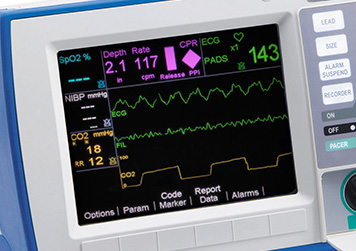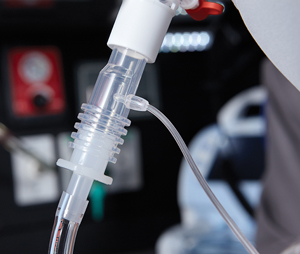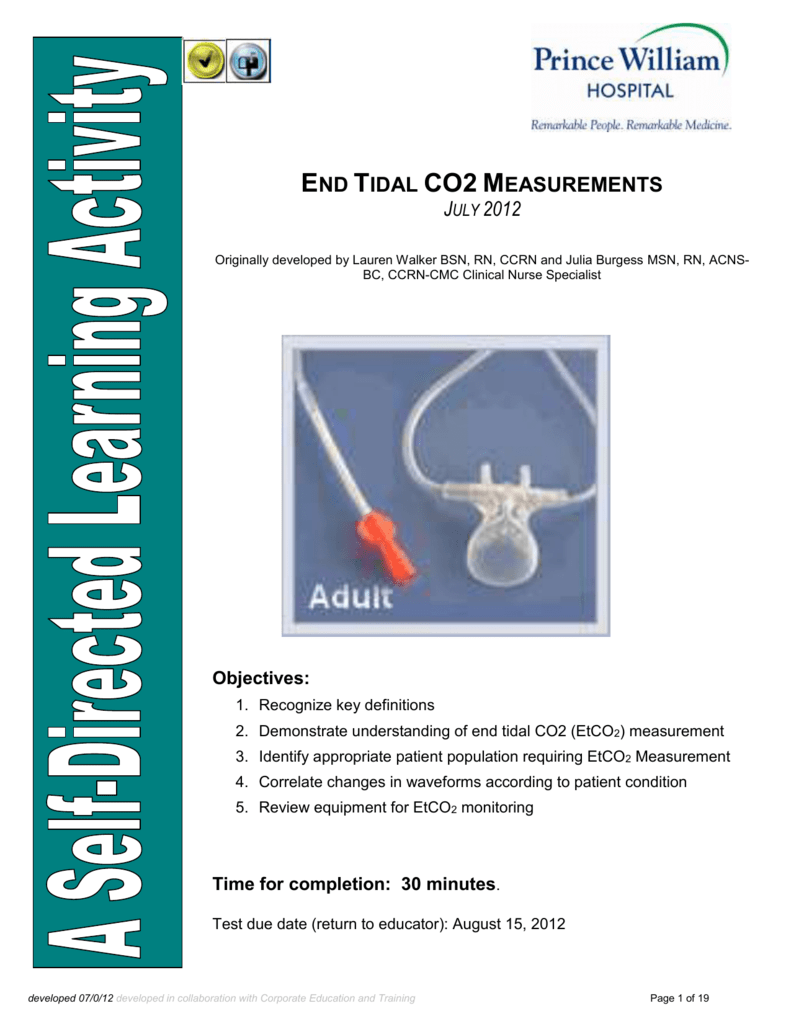end-tidal co2 monitoring non intubated patients
EtCO2 is a measurement of the partial pressure of CO2 in gas expired at the end of exhalation when exhaled gas will most closely resemble the alveolar CO2 concentration. 2 4 The.

Capnography Monitors Infinium Medical
End-tidal capnography provides reliable ventilatory monitoring for non-intubated patients presenting after sedative overdose to the emergency department.

. To understand the technical aspects of end tidal CO2 EtCO2 in the non-inva-sively ventilation NIV patient. Measuring End Tidal CO2 Daltons Law. End-tidal CO2 EtCO2 monitoring is a measure of metabolism perfusion and ventilation.
2 4 The term capnometry refers to the. In July 2013 the Journal of Emergency Medicine published an article titled Capnography for the Non-intubated Patient in the Emergency Setting In the article Craig A. The Use of End-Tidal Capnography to Monitor Non-Intubated Patients Presenting with Acute Exacerbation of Asthma in the Emergency Department The Journal of.
The hypothesis of this validation study is that flow-through capnometry will yield a more accurate estimate of ETCO2 than. Correlation and agreement with arterial carbon dioxide. 1 Although commonly used in intubated patients receiving mechanical ventilation this technique is sometimes used in non-intubated patients.
Carbon dioxide CO 2 along with oxygen O 2 share the role of being the most important gases in the human bodyThe measuring of expired CO 2 at the mouth has solicited growing clinical interest among physicians in the emergency department for various indications. Understanding End Tidal CO 2 Monitoring. Of distal end-tidal CO 2.
Clinical usefulness of EMMA for monitoring end-tidal carbon dioxide. Patients received a regional anesthesia technique while the end tidal carbon dioxide partial pressure EtCO2 was sampled through a nasal cannula Nasal FilterLine Nellcor Plesanton. End tidal CO2 is the standard of care for intubated patients.
End-tidal capnography or end-tidal CO2 EtCO2 monitoring is a non-invasive technique that measures the partial pressure or maximal concentration of carbon dioxide CO2. Both end-tidal CO2 monitors and pulse oximetry devices work closely together to help monitor the respiratory status of a patient. Kober A Schubert B Bertalanfly P et al.
Emerg Med Australas 2020. Trauma titrate end-tidal carbon dioxide EtCO2 levels in patients with suspected. 1 surveillance et monitoring of the intubated patient.
To evaluate the end tidal carbon dioxide estimation in nonintubated spontaneously breathing patients using either conventional sidestream or microstream capnometers. However none of these are theoretically as accurate as end-tidal carbon dioxide CO 2 monitoring in the non-cardiac-arrest patient. 1 Although commonly used in intubated patients receiving mechanical ventilation this technique is sometimes used in non-intubated patients.
The graphical representation of EtCO 2 is shown in a waveform format and is known as a capnogram. In this study the aim was to review the. End-tidal CO2 monitoring has many clinical uses.
If their respiratory. Confirmation of endotracheal tube placement monitoring of intubated patients or monitoring of children undergoing procedural sedation. Waveform capnography should be monitored in all intubated patients and displayed on the monitor as above.
To determine if the slope of Phase II and Phase III and the alpha angle of the expiratory capnographic waveform as measured via computer-recognizable algorithms can reflect changes in bronchospasm in acute asthmatic non-intubated patients presenting to the emergency department ED. Masui 62 2013 pp. End tidal carbon dioxide ETCO 2 monitoring is the non-invasive measurement of exhaled CO 2.
In this prospective study carried out in a university. Rience is limited in monitoring EtCO2 during NIV but there is a clear under-standing that this could offer important clinical information to rapidly maxi-mize CO2 elimination and decrease work of breathing. ETCO2 emergency department monitoring and critical.
End-tidal CO2 monitoring is a non-invasive way to monitor a patients carbon dioxide levels. End-tidal carbon dioxide ETco 2. It is also worth mentioning that EtCO 2 is not universally accepted for use in non-intubated patients for multiple reasons including lack of patient compliance.
What is end-tidal CO2 etCO2. Capnography in non-tracheally intubated emergency patients as an additional tool in pulse oximetry for. Patients who are not intubated will also benefit from using portable end-tidal CO2 monitoring.
Up to 10 cash back Background End tidal carbon dioxide ETCO2 in non-intubated patients can be monitored using either sidestream or flow-through capnometry Yamamori et al J Clin Monit Comput 223209220 2008. End-tidal CO2 may be useful here as an easily and immediately measurable index of changes in cardiac output. Reliable End Tidal CO2 Monitoring Equipment for Health Care Providers Worldwide.
End tidal CO 2 EtCO 2 is the maximum expired carbon dioxide. Fearon DM Steele DW. End-tidal carbon dioxide monitoring for weaning patients.
ETCO2 levels reflect the adequacy with which carbon dioxide CO2 is carried in the blood back to the lungs and exhaled. End-tidal carbon dioxide ETCO2 is the level of carbon dioxide that is released at the end of an exhaled breath. Manifold DO et al describe common use case scenarios for monitoring end-tidal CO2 etCO2 in intubated patients.
Norm al EtCO2 levels 46 to 60 kPa signify adequate perfusion. Available evidence has established that ETCO2 measurement can provide an indication of cardiac output and pulmonary blood flow24 Non. 31 Page 3 of 6.
And because its software is compatible with both intubated and non-intubated patients the Infinium EnTide is appropriate for use in a wide variety of situations. End-tidal carbon dioxide monitoring refers to the noninvasive measurement of exhaled carbon dioxide and is most useful when applied directly to patient care. Also called capnometry or capnography this noninvasive technique provides a breath-by-breath analysis and a continuous recording of ventilatory status.
In patients with normal pulmonary function CO 2 normally 35 to 45 mm Hg and ETco 2 should correlate closely with a deviation of about 2 to 5 mm Hg. The normal alveolar CO 2 pressure is about 40 mm Hg pressure Guyton 1984. ETCO2 MONITORING NON-INTUBATED PATIENTS Escambia County Florida - ALSBLS Medical Protocol Approved.
We describe and evaluate a method for continuously monitoring. End tidal CO 2 monitoring is represented as a number and a graph on a monitor. 2 verification of the correct positioning.
End-tidal carbon dioxide ETco 2 monitoring provides valuable information about CO 2 production and clearance ventilation. In fact its commonly called the ventilation vital sign. Whether it will be used in the operating room or at a patients bedside this monitor will.

A Systematic Approach To Capnography Waveforms Rt

The Critical Role Of Capnography Bound Tree

Capno 101 How Does Capnography Work Capnoacademy Capnoacademy

Nonin Respsense Capnography Monitor Docs Education

The Exciting Future Of Pediatric Capnography Bound Tree

More Than A Tube Capnography As An Every Day Tool Bound Tree

Nonin Respsense Ii Etco2 Monitor Respiratory Monitoring

How To Read And Interpret Capnography Waveforms Infinium Medical

Waveform Capnography In The Intubated Patient Emcrit Project

24 Hours Trend Palm Mini End Tidal Co2 Digital Monitor Etco2 Co2 Monitor Sports Outdoors

A Systematic Approach To Capnography Waveforms Jems Ems Emergency Medical Services Training Paramedic Emt News

End Tidal Co2 Etco2 Capnography For R Series Zoll Medical

Monitoring Ventilation With Capnography Nejm
End Tidal Co2 Monitors Infinium Medical

Medtronic Physician Patient Alliance For Health Safety

3 Things To Know About Capnography And Advanced Airways Capnoacademy Capnoacademy

1 Which Patient Would Be A Good Candidate For Etco2 Monitoring

